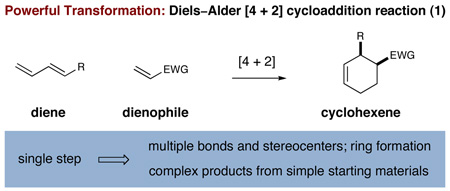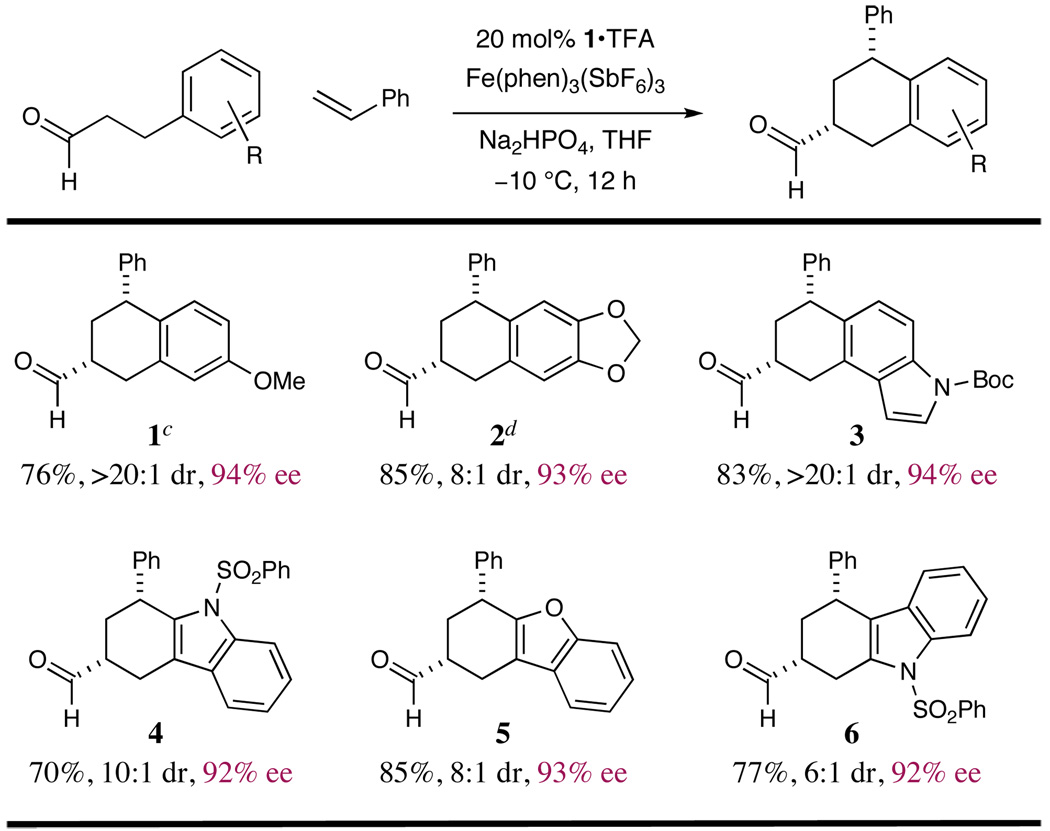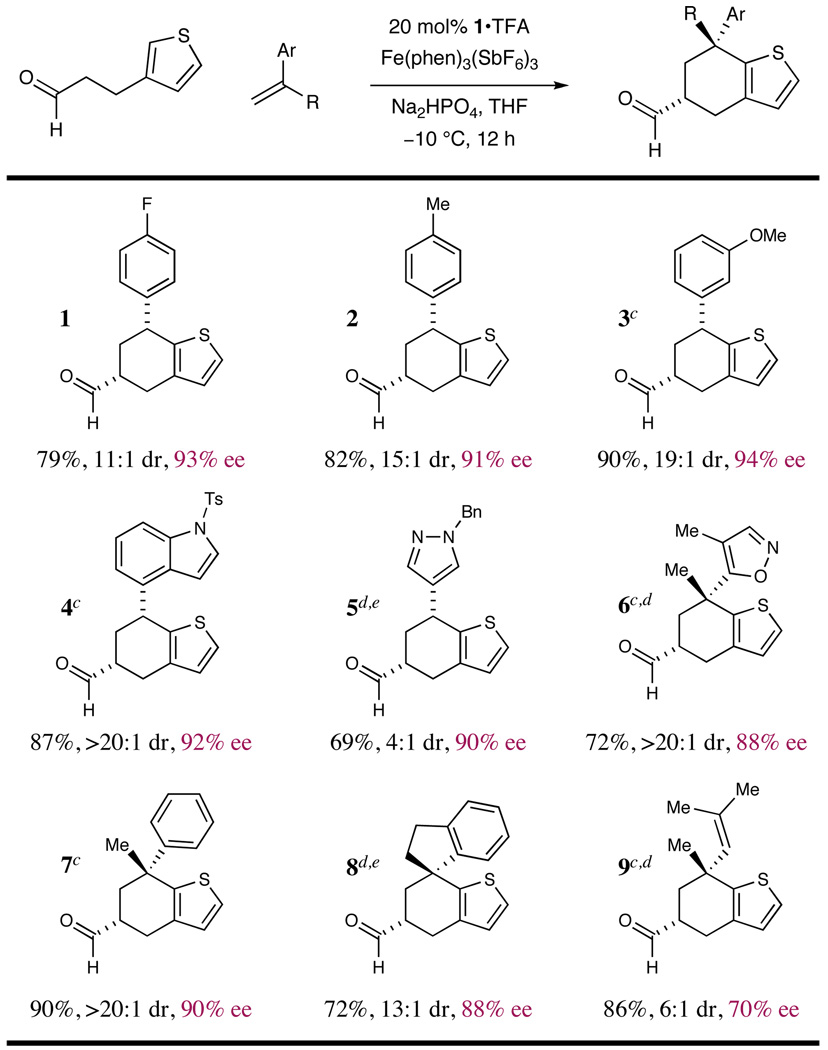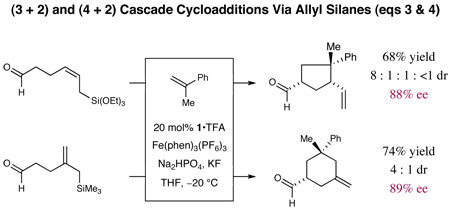Abstract
A highly selective, radical-mediated (4 + 2) coupling reaction of aldehydes and conjugated olefins has been achieved through asymmetric SOMO-catalysis. A radical-polar crossover mechanism is proposed wherein olefin addition to a transient enamine radical cation and oxidation of the resulting radical furnishes a cation which is vulnerable to nucleophilic addition. A range of aromatic aldehydes are shown to couple with styrenes and dienes to provide cyclic products with high chemical efficiency, regioselectivity, and stereoselectivity.
The identification of new transformations that allow the rapid and selective production of molecular complexity from simple starting materials remains a preeminent goal for the chemical sciences. The Diels–Alder reaction1 remains perhaps the archetypal example (eq 1), a powerful technology that builds stereochemically dense cyclohexenyl rings from simple dienes and dienophiles in a routine and predictable fashion. Recently, we questioned whether the mechanistic elements of SOMO-catalysis singly occupied molecular orbital) might be translated into a novel ring-forming protocol that would exhibit many of the valuable characteristics found in the Diels–Alder reaction. Herein, we describe the first SOMO (4 + 2) cascade cycloaddition,2 a transformation that (1) allows direct and selective access to complex cyclohexyl motifs, (2) employs simple aldehyde and olefin substrates, (3) is catalyst mediated, (4) operationally trivial, and (5) is highly predictable with respect regio-, diastereo-, and enantiocontrol. We expect that this new, stereoselective approach to carbocycle construction will be of significant utility to practitioners of both natural product and medicinal agent synthesis.
 |
Design Plan
Within the last three years, our laboratory has introduced a new mode of activation termed SOMO-catalysis that has enabled the first direct enantioselective allylic alkylation,3 enolation,4 vinylation,5 arylation,6 and carbo-oxidation7 of aldehydes, all of which were previously unknown in racemic or asymmetric format. In the latter reaction, we demonstrated that styrenyl olefins readily couple with transiently generated 3π-electron systems to generate highly reactive benzylic cations under oxidative conditions that rapidly trap NO3− to afford γ-oxyhomobenzylic aldehydes. Recently, we hypothesized that this radical-polar crossover mechanism8 and the putative benzylic cation might provide the design elements for a novel SOMO-cycloaddition reaction. As detailed in equation 2, we hoped that exposure of a π -nucleophile-tethered aldehyde to SOMO-activation using imidazolidinone catalyst 1 and an oxidant would generate the radical cation 2, which should rapidly engage an olefinic substrate in an enantioselective alkylation step to produce the alkyl radical 3. Oxidative radical-polar crossover would then furnish a carbocation that should trigger a stereoselective π-nucleophile ring closure to deliver a complex cyclohexyl motif. In accord with previous SOMO-studies, 3–7 we presumed that high levels of enantioinduction should be possible using catalyst 1 on the basis of 3 π-electron geometry control and selective methyl group shielding of the radical cation Si-face. Furthermore, we presumed that the cyclization step should be stereoselective based on the kinetic preference for chair-like transition states9 wherein pseudo-ring substituents are located in equatorial orientations.
 |
Results
After examining various single-electron oxidants,10 we found that the trisphenanthroline complexes of iron(III) bearing non-nucleophilic counterions (e.g. PF6−, AsF6−, and SbF6−)11 do indeed promote the desired cyclization reaction between 3-arylpropionaldehydes and styrene (3 equiv) with excellent levels of enantiocontrol. Furthermore, the diastereoselectivity of the cyclization event appears to vary as a function of the oxidant counterion (with the largest counterion, SbF6−, being the most selective). A possible explanation for this trend is that the stereodetermining chair-like transition state (4) is more ordered (or later) when the intermediate carbocation is paired with a more polarizable or stabilizing counterion such as SbF6−.12
Having developed optimal conditions for this new cascade olefin-addition/Friedel–Crafts sequence, we next examined the scope of the aldehydic component. As shown in Table 2, a wide range of electron-rich benzenes and heteroarenes (indoles, anisoles, catechols, benzofurans) can function as suitable nucleophilic terminators to furnish the desired cyclohexyl rings with excellent stereoselectivity (entries 1–6, 6–20:1 dr, ≥ 92% ee). Interestingly, substrates that can generate either six- or seven-membered cyclo-adducts, lead exclusively to the smaller ring (entries 3–5), regardless of the relative π-density of the tethered nucleophile.
Table 2.
 |
Results listed as product, yield, diastereomeric ratio (dr), enantiomeric excess (% ee).
Diastereomeric ratio, % ee determined as in Table 1.
Yield contains 7% ortho-coupled isomer.
Reaction conducted at −20 °C.
As highlighted in Table 3, this new coupling is also tolerant to a broad array of olefinic reaction partners. For example, styrenes of varying electronic properties readily participate in this formal [4 + 2] reaction without loss in yield or enantiocontrol (entries 1–3, 79–90% yield, 91–94% ee). Furthermore, α-substituted styrenes react smoothly to construct quaternary benzylic centers with good to excellent diastereocontrol (Table 3, entries 6–8, ≥13:1 dr, ≥88% ee). Vinyl heteroaromatics also couple efficiently in this protocol to incorporate electron-deficient ring systems, a chemotype that should be of value to practitioners of medicinal chemistry (Table 3, entries 5,6). Importantly, this tranformation is not restricted to styrenyl olefins as we have found that dienes readily participate in this cascade cycloaddition, albeit with lower levels of enantiocontrol (entry 9, 70% ee).
Table 3.
 |
Results listed as product, yield, diastereomeric ratio (dr), enantiomeric excess (% ee).
Diastereomeric ratio, % ee determined as in Table 1.
Reaction conducted at −20 °C.
Reaction performed with Fe(phen)3(PF6)3 as oxidant.
Reaction conducted at −40 °C.
Finally, we sought to determine if other carbogenic π-nucleophiles might be employed in lieu of aromatic terminators in the cation-trapping cyclization event. Indeed, as shown in equations 3 and 4, formyl tethered allylsilanes readily undergo (3 + 2) and (4 + 2) cascade cycloadditions to produce both cyclopentyl and cyclohexyl rings with good enantiocontrol and useful diastereoselectivities (≥ 68% yield, ≥4:1 dr, ≥88 % ee).
 |
In summary, a fundamentally new approach to the direct construction of six- and five-membered carbocycles from aldehydes and conjugated olefins has been achieved using enantioselective SOMO-catalysis. Further studies directed toward the application of this technology to the construction of heterocyclic adducts will be outlined in due course.
Supplementary Material
Table 1.
SOMO-Cascade (4 + 2) Cycloaddition: Counterion Effects
Determined by crude 1H NMR analysis using an internal standard.
Isolated yield.
Determined by chiral HPLC analysis of alcohol; absolute stereochemistry assigned by X-ray crystal structure or by analogy.
Acknowledgement
Financial support was provided by NIHGMS (R01 01 GM093213-01) and kind gifts from Merck, Amgen, and Abbott.
Footnotes
Supporting Information Available. Experimental procedures, structural proofs, and spectral data for all new compounds are provided (49 pages) (PDF).
References
- 1. Diels O, Alder K. Justus Liebigs Ann. Chem. 1928;460:98. For reviews on the Diels–Alder reaction, see: Corey EJ. Angew. Chem., Int. Ed. 2002;41:1650. doi: 10.1002/1521-3773(20020517)41:10<1650::aid-anie1650>3.0.co;2-b. Nicolaou KC, Snyder SA, Montagnon T, Vassilikogiannakis G. Angew. Chem., Int. Ed. 2002;41:1668. doi: 10.1002/1521-3773(20020517)41:10<1668::aid-anie1668>3.0.co;2-z.
- 2.Cascade cycloaddition refers to a reaction that unites multiple reaction partners to form a cyclic product via a cascade mechanism, which is in accord with the IUPAC Gold Book definition of cycloaddition.
- 3.Beeson TD, Mastracchio A, Hong J-B, Ashton K, MacMillan DWC. Science. 2007;316:582. [PubMed] [Google Scholar]
- 4.Jang H-Y, Hong J-B, MacMillan DWC. J. Am. Chem. Soc. 2007;129:7004. doi: 10.1021/ja0719428. [DOI] [PubMed] [Google Scholar]
- 5.Kim H, MacMillan DWC. J. Am. Chem. Soc. 2008;130:398. doi: 10.1021/ja077212h. [DOI] [PubMed] [Google Scholar]
- 6.(a) Nicolaou KC, Reingruber R, Sarlah D, Bra¨se S. J. Am. Chem.Soc. 2009;131:2086. doi: 10.1021/ja809405c. Correction: J. Am. Chem. Soc.2009, 131, 6640. [DOI] [PubMed] [Google Scholar]; (b) Conrad JC, Kong J, Laforteza BN, MacMillan DWC. J. Am. Chem. Soc. 2009;131:11640. doi: 10.1021/ja9026902. [DOI] [PMC free article] [PubMed] [Google Scholar]
- 7.Graham TH, Jones CM, Jui NT, MacMillan DWC. J. Am. Chem. Soc. 2008;130:16494. doi: 10.1021/ja8075633. [DOI] [PMC free article] [PubMed] [Google Scholar]
- 8.Murphy JA. The Radical-Polar Crossover Reaction. In: Renaud P, Sibi MP, editors. Radicals in Organic Synthesis. Vol. 1. Weinheim, Germany: Wiley-VCH; 2001. 298 pp. [Google Scholar]
- 9.(a) Zimmerman HE, Traxler MD. J. Am. Chem. Soc. 1957;79:1920. [Google Scholar]; (b) Yang J. Six-Membered Transition States in Organic Synthesis. Hoboken, NJ: Wiley-Interscience; 2008. and references therein. [Google Scholar]
- 10.The use of ceric ammonium nitrate as oxidant (as in previous studies) was, for this cascade cycloaddition, unsuccessful as it resulted in selective formation of benzylic nitrates (see ref 7).
- 11.(a) Wong CL, Kochi JK. J. Am. Chem. Soc. 1979;101:5593. [Google Scholar]; (b) Connelly NG, Geiger WE. Chem. Rev. 1996;96:877. doi: 10.1021/cr940053x. and references therein. [DOI] [PubMed] [Google Scholar]
- 12. Olah GA, Prakash GKS, Molnár Á, Sommer J. Superacid Chemistry. Hoboken, NJ: John Wiley & Sons, Inc.; 2009. For an illustrative example of counterion effects on carbocation stability, see: Reed CA. Chem. Commun. 2005:1669. doi: 10.1039/b415425h.
Associated Data
This section collects any data citations, data availability statements, or supplementary materials included in this article.




